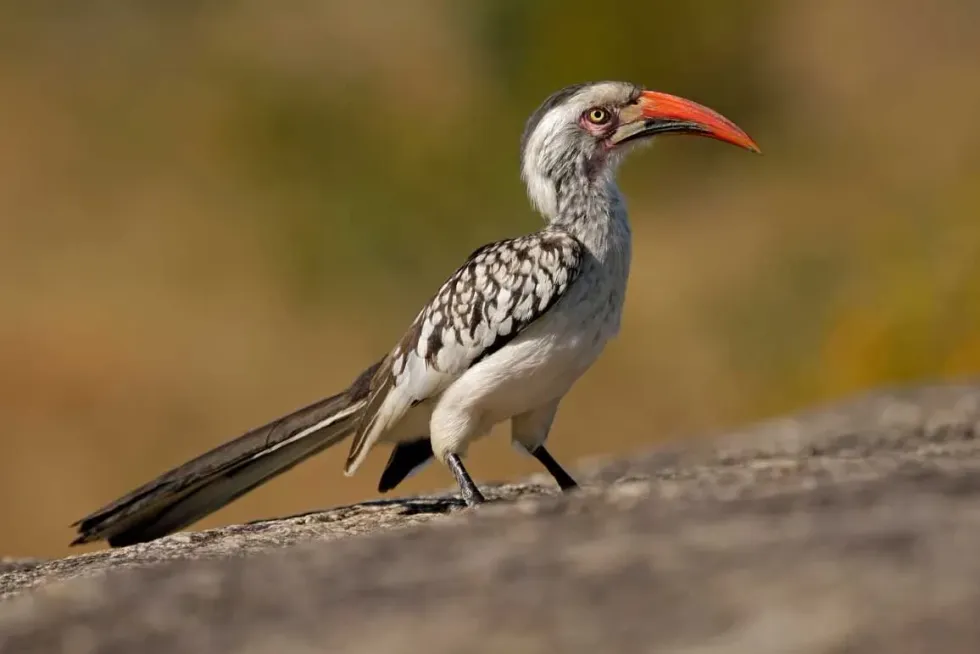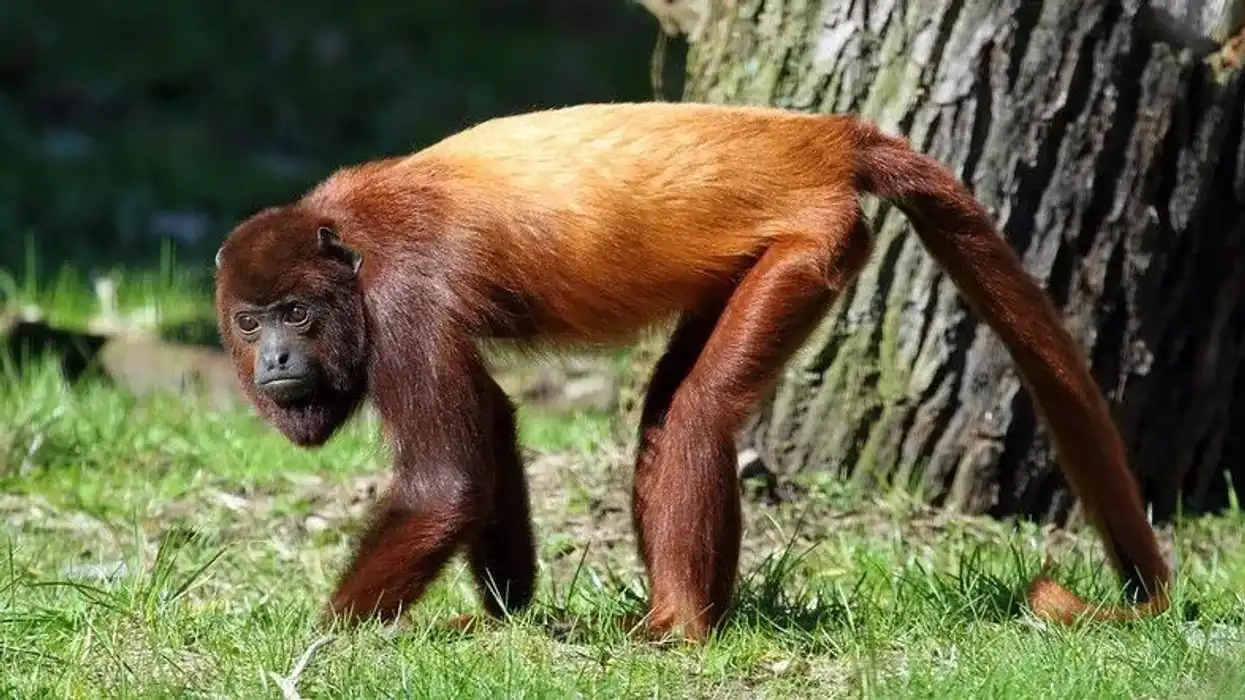The red-billed hornbill is a unique bird that you would definitely love to know all about! As the name suggests, this bird has its most prominent feature in the form of a red, curved bill that stands out against the rest of its body.
This bird also has a black-white body which appears smaller compared to its large bill, but this beak proves to be an asset whether they be eating fruits or insects.
They can crack tough nuts as well as thick-skinned fruits with their beak. But not just that, this species is an ecological superstar because of its role in maintaining the environment it lives in!
Though this bird finds its habitat in the middle of Africa, it sniffs out insects with its nose, and eats them right up!
In fact, their insect consumption is so heavy that it keeps the African insect population under control. Therefore, they are so much more important than what we initially thought of them!
If you wish to learn all about the red-billed hornbill wingspan, or the red-billed hornbill characteristics along with other fun facts about this unique bird, then continue reading on! Do not forget to check out hummingbird facts and blue jay facts.
Red-Billed Hornbill Interesting Facts
What type of animal is a red-billed hornbill?
The red-billed hornbill is a type of bird.
What class of animal does a red-billed hornbill belong to?
They belong to the class Aves.
How many red-billed hornbills are there in the world?
Although the worldwide population has not been formally determined, this species is ubiquitous and locally frequent.
Where does a red-billed hornbill live?
These birds are native to Africa, order Bucerotiformes, live in the savanna. Southern Mauritania to Somalia is the range of the northern red-billed hornbill. They prefer to stay put, defending a territory of about 10 hectares.
What is a red-billed hornbill's habitat?
The red-billed hornbill's habitat is in arid savanna, open woodlands, and thorn scrubs.
Who do red-billed hornbills live with?
These gregarious and territorial birds, hunting for ground-dwelling insects, live in small family groups or pairs.
How long does a red-billed hornbill live?
The red-billed hornbill's lifespan is about 15 years.
How do they reproduce?
The females' hornbill defends her chicks by erecting a barrier across the entrance to her nest. Then, in the enclosed chamber or nest, the female shuts herself in and raises her chicks.
The female lays three to six white eggs inside a tree hole covered with mud, excrement, and fruit pulp. There will be only one little slit. This slit is barely large enough for the male bird to feed the female and chicks.
The mother breaks out and reconstructs the wall whenever the chicks and females have become too big ((eldest red-billed hornbill chick reaches 21-22 days) for the nest. Both parents then feed the chicks. Chicks spend roughly six months with their parents.
Both the toco toucan parents incubate the eggs lasting 16-20 days. After hatching eggs, they care for the chicks for the next six to eight weeks.
What is their conservation status?
The conservation status of this African red-billed hornbill is of Least Concern as listed by the IUCN Red List. However, the conservation status of rhinoceros hornbills is Vulnerable.
Red-Billed Hornbill Fun Facts
What do red-billed hornbills look like?

The underparts and heads of this species are white. On the forehead, there is a smokey stripe that extends over the crown. Dark brown is the color of the back, with a white stripe running along the middle.
The wings are mostly a deep brown color with prominent white spots. The long tail is a dark brown color. They have characteristic orange-red jaws and are slightly curved.
Female has smaller red bill than male. Juvenile is duller than adults but similar. It has a shorter and straighter red bill than adults.
Males and females are similar. However, the female's red bill is smaller than the male's. Adults are duller, although juveniles are comparable. It owns a red bill that is straighter and smaller than adults. These peculiarly curved bills are used for courtship behaviors, foraging, and breaking out of the mud-sealed nest holes.
How cute are they?
Their captivating look is due to their magnificent, unusually curled, big red bill. As such, they definitely fall on the cuteness spectrum for us.
How do they communicate?
This hornbill makes clucking noises that get louder and louder. The red-billed hornbill call is quacking with a lowered head and partly extended wings during exhibitions. During her stay in the nest, females molt. When females emerged, their wings re-grow.
How big is a red-billed hornbill?
The average length of this Africa species is between 19-24in (48-61 cm). The great hornbill length measures up to 37.4-47.2 in (95-120 cm). Red-billed birds are smaller than great hornbills.
How fast can a red-billed hornbill fly?
Instead of hopping, these hornbills (order: Bucerotiformes) run. These birds have short wings and fly with a flap-and-glide flying pattern. While clinging to a tall tree trunk around a nest site, the long tail can be employed as a brace.
How much does a red-billed hornbill weigh?
The red-billed hornbill, Tockus erythrorhynchus, weighs less than 1lb (0.50 kg).
What are the male and female names of the species?
The male or female of these birds doesn't have any specific title.
What would you call a baby red-billed hornbill?
There is no special name for babies of these species.
What do they eat?
These birds are omnivorous, feeding insects, seeds, fruit, bird’s eggs as their diet. Small rodents are also included in their diet. Outside of the breeding season, they graze primarily mostly on the ground and establish flocks. It eats in flocks of 40-80 birds or pairs on the ground.
The dwarf red-billed hornbill is a hornbill species belonging to the Bucerotidae family that may be found in the rainforest of Africa. Fruit, insects, and small animals are the favorite food of these hornbills.
Because the tongues are too small to manage food trapped at the point of the beak, they throw it back towards the throat with a twist of the head.
Are they poisonous?
The red-billed hornbill species is not a poisonous animal.
Would they make a good pet?
Tockus hornbills are among the few softbills that can make excellent pets. The bigger hornbill species can also be docile pets, but the size prevents them from becoming domestic pets.
Did you know...
Zazu is an African red-billed hornbill species that appears in the animated movie, The Lion King.
Mongooses and red-billed hornbills hunt together; the mongooses smell out and expose insects, whereas the hornbills keep an eye out for predators and emit alarm sounds!
Why are red-billed hornbills important for a healthy ecosystem?
These birds play a crucial part in sustaining a healthy ecosystem by helping to prevent the increase in the population of insects.
Are red-billed hornbills endangered?
The red-billed hornbill species are found throughout Africa and are classified as of Least Concern by the World Conservation Union. Large adders and raptors are predators of these hornbills. Weasels, monkeys, and snakes are the main predators to young keen-billed toucans (similar-looking animal to the hornbill) and their eggs.
Here at Kidadl, we have carefully created lots of interesting family-friendly animal facts for everyone to discover! Learn more about some other birds from our Amazon parrot facts and toco toucan facts pages.
You can even occupy yourself at home by coloring in one of our Red-billed hornbill coloring pages.










